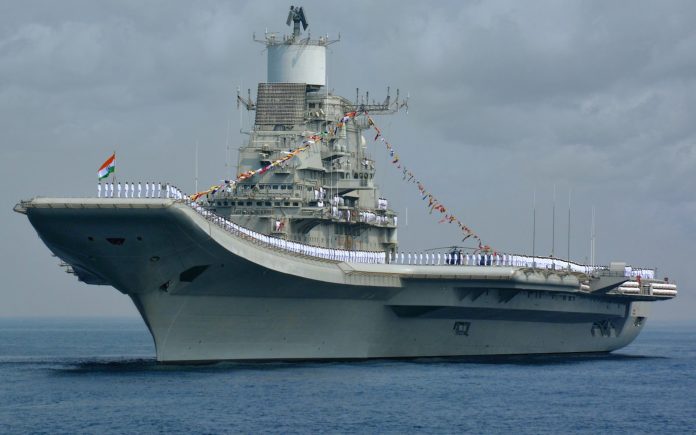New Delhi: Construction of the Admiral Grigorovich stealth-guided missile frigates is currently underway in Russia; however, these vessels are equipped with Ukrainian engines. The ongoing conflict in Ukraine has placed India in a challenging dilemma, leading to delays in the completion of the two remaining ships of this class.
The issue is set to be resolved in the near future as Kalyani Strategic Systems (KSSL) has taken a controlling interest in the Indian division of Ukrainian Zorya Mashproekt. Zorya Mashproekt is responsible for producing the engines used in the Admiral Grigorovich-class frigates, among other products. The Admiral Grigorovich-class, weighing 3,620 tons, represents an enhanced version of the six Talwar-class frigates that Russia constructed for the Indian Navy from 2003 to 2013.
The acquisition agreement, signed on May 9, 2023, by Bharat Forge’s wholly-owned subsidiary, Kalyani Strategic Systems (KSSL), was successfully concluded on December 31, 2023, according to information obtained by the EurAsian Times.
In October 2016, India and Russia entered into an Inter-Governmental Agreement for the procurement of four stealth frigates. Following this, a direct purchase deal worth $1 billion was finalized to facilitate the acquisition process.
The foundational frameworks of the initial two frigates are situated at the Russian shipyard Yantar, where ongoing construction is taking place. Notably, these vessels are propelled by Ukrainian engines, a result of India’s successful persuasion of the Ukrainian government in 2019. This effort led to the provision of two ship engines to the Russian shipyard in Kaliningrad, a semi-exclave located in northern Europe, bordered by Belarus and Latvia to the East.
In November 2018, Goa Shipyard Limited (GSL) and Russia’s Rosoboronexport entered into a $500 million agreement to provide materials, design, and specialized assistance for the local production of the remaining two frigates. Following this, the Indian Defence Ministry and GSL formalized a contract for the same services in January 2019.
Presently, GSL is actively engaged in the construction of these two stealth frigates, and the scheduled delivery dates will be determined according to the agreed-upon payment plan. In response to Kyiv’s decision to ban military exports to Russia in 2014, India will directly procure two M90FR gas turbine engines for the frigates from Ukraine.
Although Russia initially announced that the two frigates under construction at its shipyard would be delivered in May and October 2024, a later report from the EurAsian Times suggested that the delivery dates for these frigates have been postponed to 2025. This is noteworthy, especially as the Indian Navy has already selected the crew members for these vessels.
These two upcoming frigates mark the conclusion of an era as they will be the final Indian Navy warships constructed at a foreign shipyard. The Indian Navy currently boasts 68 warships, collectively valued at Rs. 200,000 crores ($2.5 billion), which are in various stages of production.
Upon the receipt of the frigates from Russia, the Indian Navy will have achieved a milestone by having all its warships manufactured in domestic shipyards. This transition reinforces the significance of India’s acquisition of stakes in Zorya Mashproekt, presenting a substantial boost to the country’s shipbuilding industry.
The existing fleet includes six frigates of the Talwar class, all propelled by engines from Zorya Mashproekt. Zorya Mashproekt India Private Limited (ZMI), established on August 12, 2022, is a critical entity contributing to the development of indigenous capabilities for building, repairing, and overhauling gas turbine engines. Despite being a pre-revenue company with no turnover since its inception, ZMI plays a crucial role in the Indian defense sector.
The conflict between Ukraine and Russia poses potential risks to the operational readiness of the Indian Navy. ZMI emerges as a vital player, specializing in the development and servicing of gas turbine engines that power a variety of naval vessels. The establishment of ZMI in India serves as an innovative solution to navigate the challenges arising from the ongoing war and ensures the continued support for the Indian Navy’s strategic capabilities.
Complicated Web Of Old Ties
The Talwar-class advanced guided missile frigates are equipped with Ukrainian engines and feature the BrahMos cruise missile system. This sophisticated weaponry is manufactured through a joint venture between India and Russia, highlighting collaborative efforts in defense technology between the two nations. The BrahMos cruise missile system is renowned for its precision and capabilities, further enhancing the offensive capabilities of the Talwar-class frigates in the Indian Navy’s fleet.
The two-stage BrahMos missile, named after the Brahmaputra River in India and the Moskva River in Russia, is derived from the Russian-made P-800 Oniks over-the-horizon supersonic anti-ship cruise missile. This collaboration signifies a joint effort in adapting and enhancing existing missile technology to create a versatile and powerful system that incorporates the strengths of both Indian and Russian expertise. The BrahMos missile has gained recognition for its speed, precision, and effectiveness, making it a crucial component of the naval arsenal for both countries.
In addition to the BrahMos missile system, the warships will be equipped with another Russian-made standoff supersonic anti-ship cruise missile, the vertically-launched 3M-54 Kalibr. Complementing the offensive capabilities, a Russian helicopter, the Ka-27, will be on board to execute anti-submarine warfare missions.
These frigates demonstrate impressive specifications, capable of cruising at a maximum speed of 30 knots and maintaining operational endurance at sea for nearly 30 days without the need for refueling at a naval base.
The prolonged conflict has affected various defense projects, and India, historically reliant on Russia and former USSR states for defense needs, faces challenges. India seeks collaboration with Ukraine to enhance its Antonov AN-32 fleet, procure essential R-27 air-to-air missiles for its fighter jets, and upgrade existing artillery and air defense systems. The evolving geopolitical landscape necessitates cooperation and support from key allies and partners to meet India’s diverse defense requirements.
India, being an initial customer for the Russian An-32 aircraft, entered into a contract with Ukraine in 2008, worth US $400 million, to upgrade its fleet of 105 AN-32 planes. According to the terms of the agreement, 45 of these aircraft were scheduled for upgrades in Ukraine, while the remaining were to be refurbished in Kanpur, India.
Regrettably, the progress of the project has faced setbacks as Moscow declined to provide crucial equipment necessary for the upgrade to Kyiv. This delay is rooted in the strained relations between the two former USSR states, particularly exacerbated by the Russian annexation of Crimea in 2014. The geopolitical tensions have impeded the smooth execution of defense projects, impacting the modernization plans for India’s An-32 fleet.
The Indian Air Force (IAF), diversifying its aircraft fleet, opted for Lockheed Martin C-130J Super Hercules and Boeing C-17 Globemaster III transport jets from the United States, a move aimed at reducing reliance on a single source.
In the realm of small arms, the Indian Army’s anticipation for the production of 700,000 AK-203 assault rifles through an India-Russia joint venture faced delays. This prompted the government to place an order for 70,000 Sig Sauer assault rifles from the United States. The increased militancy in Jammu and Kashmir and the ongoing border standoff with China since 2020 have added urgency to equipping the forces with modern weaponry.
Additionally, the delivery of INS Chakra, a nuclear-powered attack submarine, has encountered delays. While the Indian Navy initially leased two Akula-class submarines from Russia, economic sanctions triggered by geopolitical events have compelled both nations to explore alternative payment mechanisms. These delayed projects underscore the complex challenges faced by India in navigating defense acquisitions amidst evolving geopolitical dynamics.

